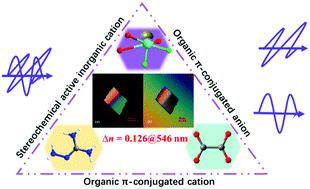An organic–inorganic hybrid birefringent material with diverse functional groups†
Abstract
Birefringent materials are vital materials to modulate the polarization of light, and play a key role in plorization devices such as linear optical devices, optical communication devices, and fiber optic sensors. It is still a challenge to design excellent birefringent materials. Herein, we report an organic–inorganic hybrid oxalate birefringent material, (CN4H7)SbC2O4F2(H2O)0.5, by introducing organic delocalized π-conjugated [CN4H7]+ and [C2O4]2− groups, and stereochemical active inorganic SbO4F2 polyhedra. (CN4H7)SbC2O4F2(H2O)0.5 exhibits a large birefringence (Δn = 0.126@546 nm) that is almost equal to that of the well-known birefringent material α-BaB2O4. Theoretical calculations reveal that the distinguished birefringence should stem from the synergistic arrangement of π-conjugated [CN4H7]+ and [C2O4]2− planar groups, and highly distorted SbO4F2 polyhedra with a stereochemically active lone pair. The synergistic effect of π-conjugated systems and the lone pair electrons greatly boosts the birefringence, which is helpful for the development of high-performance birefringent materials.

- This article is part of the themed collection: 2021 Emerging Investigators


 Please wait while we load your content...
Please wait while we load your content...